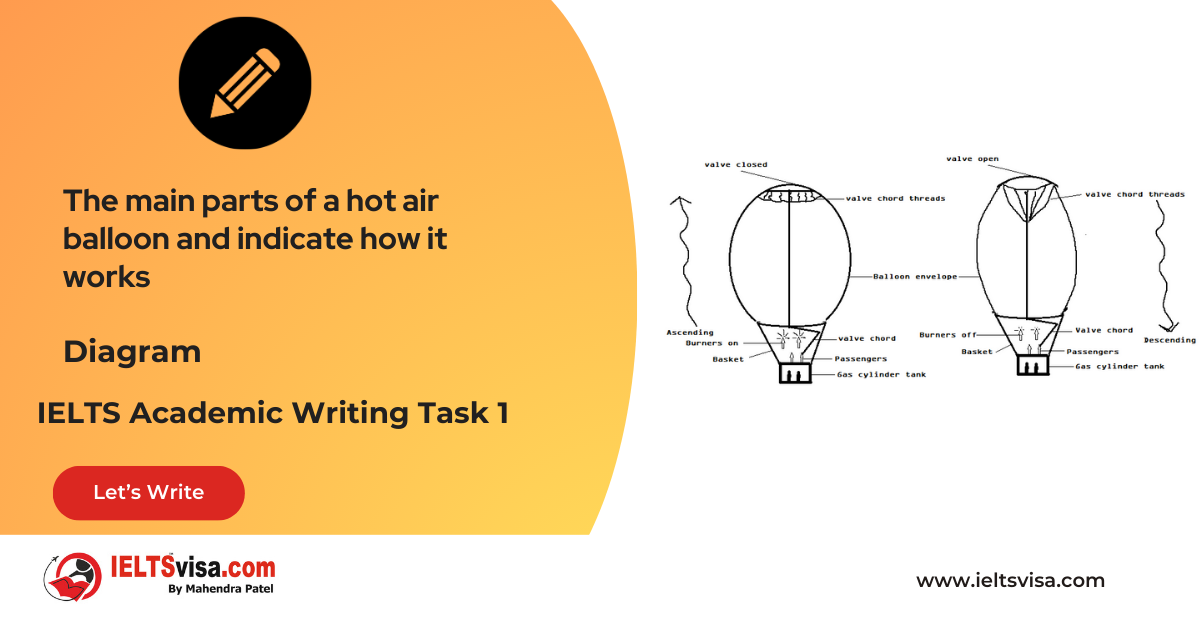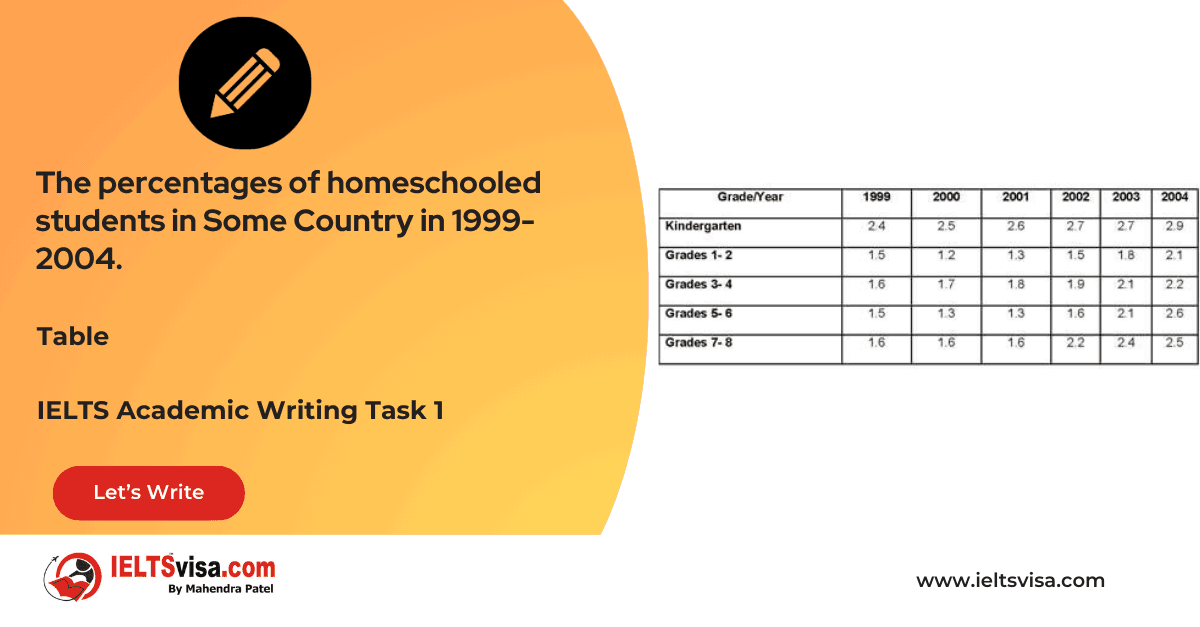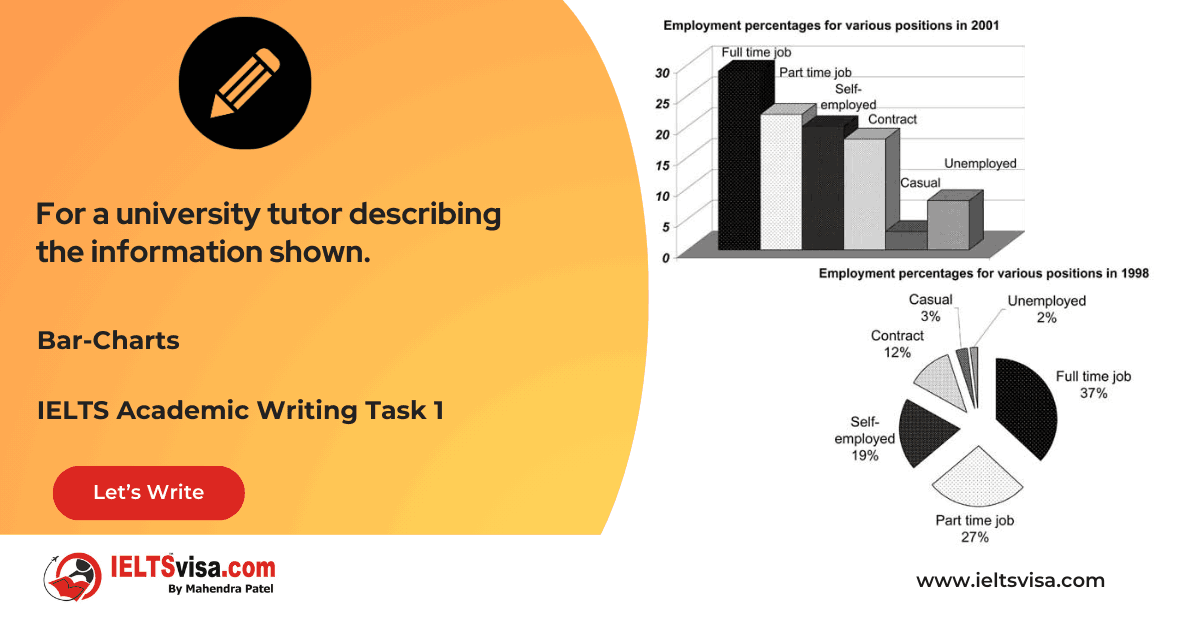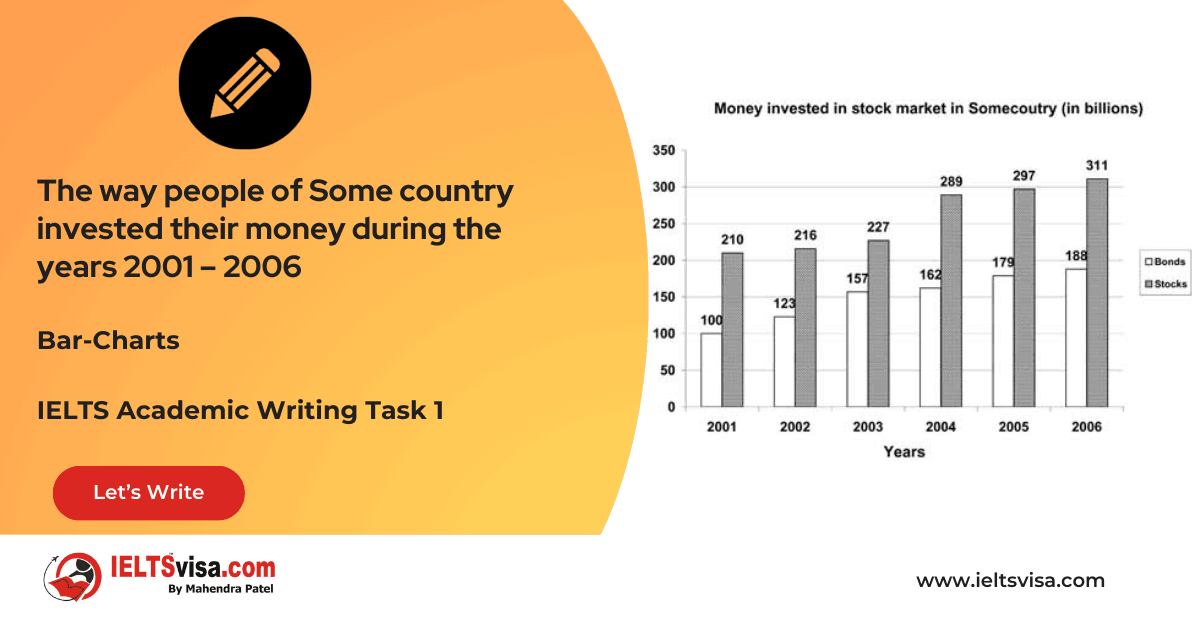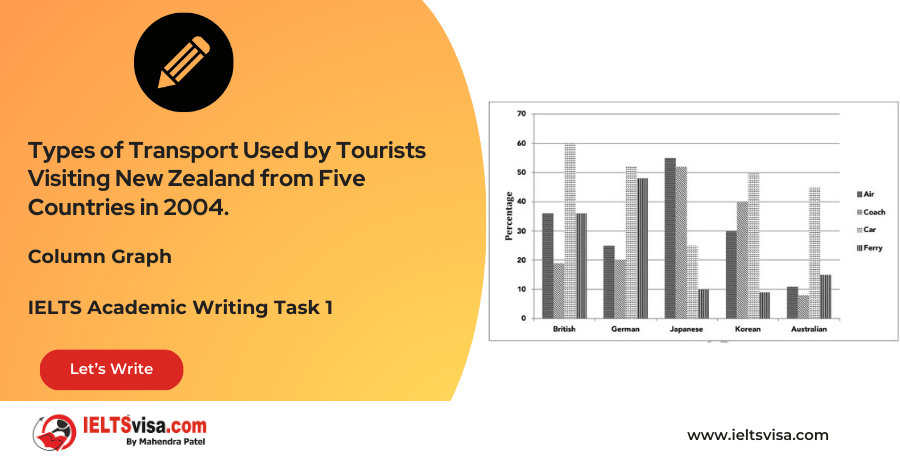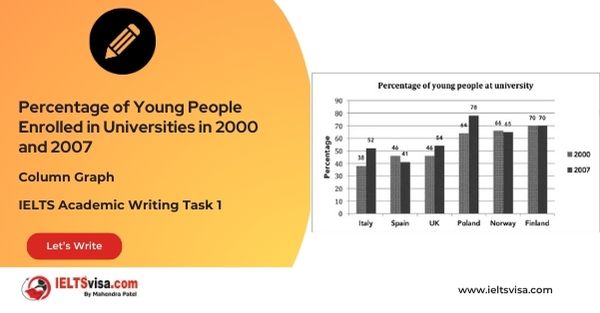Changes in the places where people used to surf the Internet in the years 1998, 2000, 2002 and 2004
IELTS Academic Writing Task 1 - Bar Graph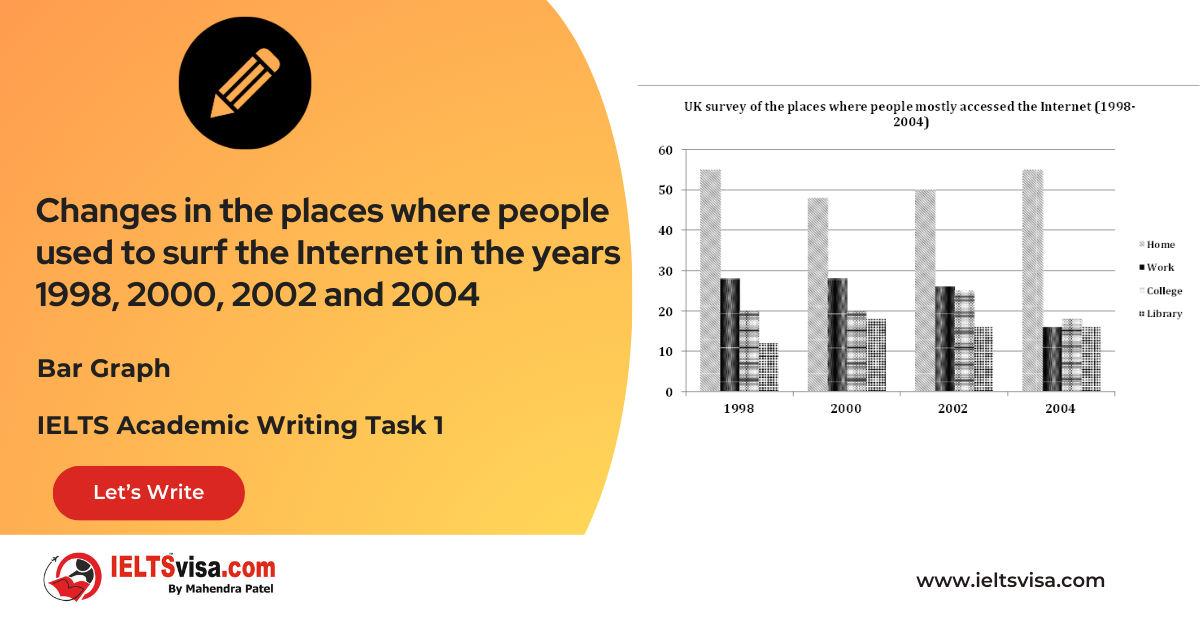
IELTS Writing Task 1 Question
The graph below shows the changes in the places where people used to surf the Internet in the years 1998, 2000, 2002 and 2004. Summarize the information by selecting and reporting the main features and make comparisons where relevant
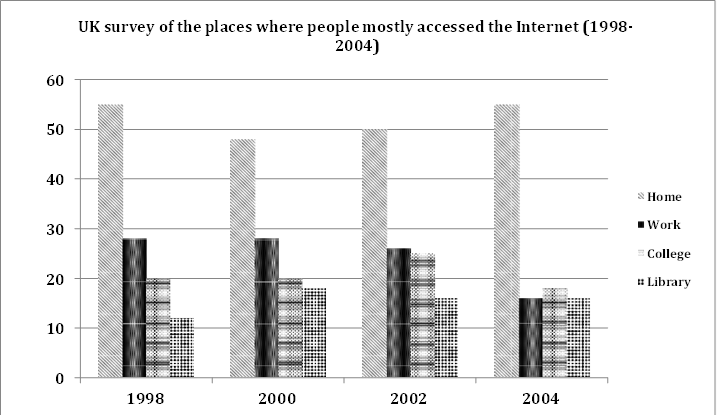
Common Questions for the Bar Graph
1. Graph Type: Column Graph
2.Title: Changes in Internet Access Locations (1998-2004)
3.Units of Measurement : Percentage of Internet users
4.Who: General population accessing the Internet
5. When: 1998, 2000, 2002, and 2004
6. Where: Various locations (home, office, college, library)
7. Topic: Trends in Internet access by location over time
Comparison Showing and Trends Any change over time (such as an increase or a decrease) is a trend.
Comparison 1 : Home Access
- Details:
1. Internet access from home was the most common method, starting at approximately 55% in 1998.
2. This percentage dropped to 48% in 2000 but increased steadily thereafter, reaching 55% again by 2004.
Comparison 2: Office Access
-
Details:
1. Access from the office fluctuated between 25% and 30% from 1998 to 2002.
2. However, there was a significant drop to 15% by 2004, marking a declining trend in office usage
Comparison 3 :: College and Library Access
Details:
1. The percentage of people accessing the Internet in colleges remained relatively stable at around 18%-25% throughout the years.
2. Access in libraries was the least popular, fluctuating between 12% and 18% during the same period
Sample Answer
The column graph illustrates the changes in locations where people accessed the Internet from 1998 to 2004. It is evident that home remained the most popular place for Internet use throughout the years.
In 1998, approximately 55% of users accessed the Internet from home, but this figure declined to about 48% in 2000. Following this dip, home access steadily increased again, reaching 55% by 2004. The office was the second most common location for Internet use, with a stable proportion of 25%-30% from 1998 to 2002. However, this figure dropped sharply to 15% in 2004.
Access from colleges fluctuated between 18% and 25% during the observed years, indicating a relatively consistent trend. Conversely, library access remained the least utilized, with a percentage fluctuating between 12% and 18%.
Overall, the data highlights a significant discrepancy between home Internet access and usage in other locations, which remained consistently lower across the four years.
Top 27 Vocabularies
| Vocabulary | Type | Meaning | Synonyms | Examples |
| Illustrate | Verb | To show or represent | Depict, demonstrate, present | “The graph illustrates the changes in Internet access locations.” |
| Fluctuate | Verb | To vary or change irregularly | Vary, oscillate, change | “Access in libraries fluctuated between 12% and 18%.” |
| Proportion | Noun | A part or fraction of a whole | Percentage, share, segment | “The proportion of home access increased steadily.” |
| Discrepancy | Noun | A difference or inconsistency | Inconsistency, disparity, divergence | “There was a high discrepancy between home access and other locations.” |
| Steadily | Adjective | In a gradual, even manner | Consistently, continuously, regularly | “Home access increased steadily after 2000.” |
| Access | Verb/Noun | The ability to enter or use something | Entry, usage, approach | “People accessed the Internet primarily from home during the observed years.” |
| Remain | Verb | To continue to exist, stay in the same state | Stay, persist, continue | “Home remained the most popular place for Internet use throughout the years.” |
| Popular | Adjective | Liked or enjoyed by many people | Favored, preferred | “Home was the most popular place for accessing the Internet.” |
| Decline | Verb | To decrease in amount, quality, or importance | Decrease, reduce, diminish | “The percentage of home Internet users declined in 2000.” |
| Dip | Noun/Verb | A temporary or slight decrease | Drop, fall, reduction | “There was a dip in home Internet access in 2000.” |
| Increase | Verb/Noun | To grow or become greater in size, amount, or degree | Rise, grow, expand | “Access to the Internet from home increased steadily after 2000.” |
| Sharply | Adverb | Suddenly and by a large amount | Drastically, steeply | “Office Internet access dropped sharply in 2004.” |
| Common | Adjective | Occurring or found often | Frequent, usual, widespread | “The office was a common place for Internet use until 2004.” |
| Stable | Adjective | Not changing or fluctuating; consistent | Steady, constant | “The proportion of office Internet access was stable between 1998 and 2002.” |
| Fluctuation | Noun | A change or variation in amount | Variation, oscillation | “Internet access from colleges showed slight fluctuations.” |
| Relatively | Adverb | In comparison to something else | Comparatively, somewhat | “College Internet access remained relatively stable throughout the years.” |
| Indicate | Verb | To show or point out something | Show, signify, demonstrate | “The data indicates that home access was consistently higher.” |
| Consistent | Adjective | Unchanging over time; steady | Reliable, steady | “College Internet access followed a consistent trend.” |
| Least | Adjective | Smallest in amount or degree | Minimal, fewest | “Libraries were the least utilized location for Internet access.” |
| Utilized | Verb | To use something effectively | Use, employ, apply | “Libraries were utilized by a smaller proportion of Internet users.” |
| Observe | Verb | To notice or see | Notice, detect, perceive | “The observed data shows significant changes over the years.” |
| Disparity | Noun | A great difference | Inequality, gap, divergence | “There was a disparity in Internet usage across different locations.” |
| Gradual | Adjective | Happening slowly over time | Progressive, steady | “There was a gradual increase in home Internet access after 2000.” |
| Evident | Adjective | Clearly seen or understood | Obvious, apparent | “It is evident that home access was the most preferred throughout the period.” |
| Sharp | Adjective | Sudden and significant | Steep, drastic | “A sharp drop was noted in office Internet access in 2004.” |
| Highlight | Verb | To emphasize or make prominent | Emphasize, underline | “The data highlights the dominance of home as the primary Internet access location.” |
| Dominance | Noun | The state of being the most important or prevalent | Supremacy, preeminence | “The dominance of home Internet access is evident in the graph.” |
| Observed | Adjective | Seen or noticed | Recorded, noted | “The observed trends reveal key patterns in Internet access.” |

Our Books
Master IELTS Speaking Part 1
IELTS Writing Task 1 Book
IELTS Writing Task 2 Book
Writing Task 1 Question Types
Practice IELTS Other Modules
IELTS Listening
The IELTS Listening test assesses how well you can understand spoken English in various contexts. It lasts about 30 minutes and is divided into four sections with a total of 40 questions. The listening tasks become increasingly difficult as the test progresses.
IELTS Academic Reading
The IELTS Academic Reading section assesses your ability to understand and interpret a variety of texts in academic settings. It is designed to evaluate a range of reading skills, including skimming for gist, reading for main ideas, reading for detail, understanding inferences, and recognizing a writer's opinions and arguments.
IELTS Speaking
The IELTS Speaking test assesses your ability to communicate in English on everyday topics. It lasts 11-14 minutes and consists of three parts: introduction, cue card, and a discussion based on the cue card topic.
IELTS General Reading
IELTS General Reading tests your ability to understand and interpret various types of texts. Here are some key areas and types of content you can expect to encounter in the reading section, along with tips for effective preparation.
IELTS Academic Writing Task 1
In IELTS Academic Writing Task 1, you are presented with a visual representation of information, such as graphs, charts, tables, or diagrams, and you are required to summarize, compare, or explain the data in your own words.
IELTS General Writing Task 1
In IELTS General Writing Task 1, you are required to write a letter based on a given situation. The letter can be formal, semi-formal, or informal, depending on the prompt. Here’s a breakdown of the key components to include in your letter
IELTS Academic Writing Task 2
In IELTS Academic Writing Task 2, you are required to write an essay in response to a question or topic. Here’s a guide to help you understand the essential elements of this task
IELTS Exam Tips
To succeed in the IELTS exam, practice regularly, familiarize yourself with the test format, improve your vocabulary, develop time management skills, and take mock tests to build confidence.
Grammer for IELTS
Grammar is the foundation of effective communication in English. Understanding tense usage, subject-verb agreement, and sentence structure enhances clarity and coherence in writing and speaking.
Vocabulary for IELTS
Vocabulary plays a crucial role in the IELTS (International English Language Testing System) exam, especially in the Speaking and Writing sections. Here’s an overview of why vocabulary is important and how it impacts your performance
RECENT IELTS SAMPLES QUESTIONS AND ANSWERS
Task 1 – Diagram – A conference hall built in 1981 and planned for 2020
20:00 Start Pause Stop [df_adh_heading title_infix="IELTS Writing Task 1 Question" use_divider="on"...
Task 1 – Table – The percentages of homeschooled students in Some Country in 1999-2004.
20:00 Start Pause Stop [df_adh_heading title_infix="IELTS Writing Task 1 Question" use_divider="on"...
Task 1 – Table – For a university tutor describing the information shown.
20:00 Start Pause Stop [df_adh_heading title_infix="IELTS Writing Task 1 Question" use_divider="on"...
Task 1 – Bar-Charts – The way people of Some country invested their money during the years 2001 – 2006
20:00 Start Pause Stop [df_adh_heading title_infix="IELTS Writing Task 1 Question" use_divider="on"...
Task 1 – Diagram – Rainwater Harvesting and Conversion to Drinking Water in an Australian Town.
20:00 Start Pause Stop [df_adh_heading title_infix="IELTS Writing Task 1 Question" use_divider="on"...
Task 1 – Column graph – Percentage of Young People Enrolled in Universities in 2000 and 2007.
20:00 Start Pause Stop [df_adh_heading title_infix="IELTS Writing Task 1 Question" use_divider="on"...

